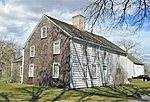Quicksand Pond
Bodies of water of Newport County, Rhode IslandLakes of Rhode IslandLittle Compton, Rhode Island

Quicksand Pond is a pond in Little Compton, Rhode Island. It is a major winter flounder spawning area, has Rare Species Habitat and Significant Natural Communities designation, and is part of a proposed natural greenway corridor. Quicksand Pond is also entirely surrounded by critical habitats, and there are a number of protected areas adjacent to Quicksand Pond. It is part of the Southeastern Coastal Watershed Basin.It is part of one of the most scenic and undisturbed coastal areas in Rhode Island, and its protection is of high priority. Approximately half of the shorelines on Quicksand Pond are undeveloped, the remainder are developed as private residences.
Excerpt from the Wikipedia article Quicksand Pond (License: CC BY-SA 3.0, Authors, Images).Quicksand Pond
Geographical coordinates (GPS) Address Nearby Places Show on map
Geographical coordinates (GPS)
| Latitude | Longitude |
|---|---|
| N 41.506493 ° | E -71.130044 ° |
Address
Pottersville
02801
Rhode Island, United States
Open on Google Maps










